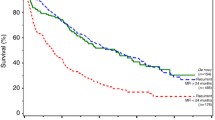Abstract
Adjuvant systemic treatment for breast cancer has evolved resulting in improved outcomes. A relevant question is whether these advances have changed the pattern of distant relapse. Women diagnosed with stage I–III breast cancer were divided into three time cohorts according to changes in adjuvant therapy; A: 1989–1991—CMF chemotherapy in premenopausal and tamoxifen for postmenopausal women; B: 1992–1997—anthracycline chemotherapy and tamoxifen for pre/postmenopausal women; C: 1998–2001—broader use of anthracyclines. The primary endpoint was 5-year cumulative incidence of bone metastasis (BM) as first site of metastasis (FSOM) versus non-bone metastasis (NBM). The ratios NBM/BM in each period were calculated. The eligibility criteria were met by 21,415 cases; Cohorts A: 1989–1991 (n = 3,915), B: 1992–1997 (n = 9,229) and C: 1998–2001 (n = 8,271). Between 1989 and 2001, the percentage of patients receiving adjuvant chemotherapy increased from 23.1 to 34.4%. A decline in cumulative 5-year incidence rates for BM and NBM as FSOM was seen comparing cohort A to C, P < 0.0001. The ratio NBM/BM was significantly increased from 1.53 in the early cohort to 2.00 in the later one, P = 0.0083. The most prominent increase (84%) was in the ER-negative group, chemotherapy treated, P = 0.0272. A significant decline in 5-year cumulative incidence of metastases and an increase in the proportion of NBM as first site of metastasis were observed between earlier and later cohorts. This may reflect the need for more successful adjuvant treatment options for aggressive breast cancer subtypes which are more likely to present with early spread to visceral organs. Understanding patterns of relapse may help design new adjuvant strategies.


Similar content being viewed by others
References
Citron ML, Berry DA, Cirrincione C et al (2003) Randomized trial of dose-dense versus conventionally scheduled and sequential versus concurrent combination chemotherapy as postoperative adjuvant treatment of node-positive primary breast cancer: first report of intergroup trial C9741/Cancer and leukemia group B trial 9741. J Clin Oncol 21:1431–1439
Perez E, Muss HB (2005) Optimizing adjuvant chemotherapy in early-stage breast cancer. Oncology (Williston Park) 19:1759–1767 discussion 1768, 1772-4, 1777-8
Lin NU, Winer EP (2008) Advances in adjuvant endocrine therapy for postmenopausal women. J Clin Oncol 26:798–805
De Laurentiis M, Cancello G, D’Agostino D et al (2008) Taxane-based combinations as adjuvant chemotherapy of early breast cancer: a meta-analysis of randomized trials. J Clin Oncol 26:44–53
Dahabreh IJ, Linardou H, Siannis F et al (2008) Trastuzumab in the adjuvant treatment of early-stage breast cancer: a systematic review and meta-analysis of randomized controlled trials. Oncologist 13:620–630
Perou CM, Sorlie T, Eisen MB et al (2000) Molecular portraits of human breast tumours. Nature 406:747–752
Goldhirsch A, Gelber RD, Castiglione M (1988) Relapse of breast cancer after adjuvant treatment in premenopausal and perimenopausal women: patterns and prognoses. J Clin Oncol 6:89–97
Perez JE, Machiavelli M, Leone BA et al (1990) Bone-only versus visceral-only metastatic pattern in breast cancer: analysis of 150 patients. A GOCS study. grupo oncologico cooperativo del sur. Am J Clin Oncol 13:294–298
Coleman RE, Smith P, Rubens RD (1998) Clinical course and prognostic factors following bone recurrence from breast cancer. Br J Cancer 77:336–340
Pintilie M (2006) Competing risks: a practical perspective. Wiley, New York
Gray RJ (1988) A class of K-sample tests for comparing the cumulative incidence of a competing risk. Ann Stat 16:1141–1154
Casella G, Berger RL (1990) Statistical inference. Duxbury Press, Belmont, pp 328–331
Davison AC, Davison DV (1997) Bootstrap methods and their application. Cambridge University Press, Cambridge, pp 82–87
Smalley RV, Scogna DM, Malmud LS (1982) Advanced breast cancer with bone-only metastases: a chemotherapeutically responsive pattern of metastases. Am J Clin Oncol 5:161–166
Dent R, Trudeau M, Pritchard KI et al (2007) Triple-negative breast cancer: clinical features and patterns of recurrence. Clin Cancer Res 13:4429–4434
Hess KR, Pusztai L, Buzdar AU et al (2003) Estrogen receptors and distinct patterns of breast cancer relapse. Breast Cancer Res Treat 78:105–118
Pritchard K (1994) Adjuvant systemic therapy for early breast cancer: a tale of relapse and survival. Lancet 343:370–371
Early Breast Cancer Trialists’ Collaborative Group (EBCTCG) (2005) Effects of chemotherapy and hormonal therapy for early breast cancer on recurrence and 15-year survival: an overview of the randomised trials. Lancet 365:1687–1717
Crabb SJ, Cheang MC, Leung S et al (2008) Basal breast cancer molecular subtype predicts for lower incidence of axillary lymph node metastases in primary breast cancer. Clin Breast Cancer 8:249–256
Whatcheressian JL, Wolff AC, Smith TJ (2006) American society of clinical oncology 2006 update of the breast cancer follow-up and management guidelines in the adjuvant setting. J Clin Oncol 24:5091–5097
Diel IJ, Jaschke A, Solomayer EF et al (2008) Adjuvant oral clodronate improves the overall survival of primary breast cancer patients with micrometastases to the bone marrow: a long-term follow-up. Ann Oncol 19:2007–2011
Powles T, Paterson A, McCloskey E et al (2006) Reduction in bone relapse and improved survival with oral clodronate for adjuvant treatment of operable breast cancer [ISRCTN83688026]. Breast Cancer Res 8:R13
Saarto T, Vehmanen L, Virkkunen P et al (2004) Ten-year follow-up of a randomized controlled trial of adjuvant clodronate treatment in node-positive breast cancer patients. Acta Oncol 43:650–656
Author information
Authors and Affiliations
Corresponding author
Rights and permissions
About this article
Cite this article
Yerushalmi, R., Woods, R., Kennecke, H. et al. Patterns of relapse in breast cancer: changes over time. Breast Cancer Res Treat 120, 753–759 (2010). https://doi.org/10.1007/s10549-009-0510-2
Received:
Accepted:
Published:
Issue Date:
DOI: https://doi.org/10.1007/s10549-009-0510-2




